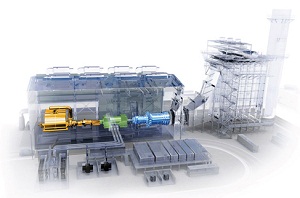General Electric introduces gas turbine designed for renewables
 General Electric (NYSE: GE) recently introduced its new FlexEfficiency gas turbine. The turbine was inspired by GE’s work with jet engines and designed to ramp power generation up or down quickly to compensate for the intermittency of renewables like solar and wind.
General Electric (NYSE: GE) recently introduced its new FlexEfficiency gas turbine. The turbine was inspired by GE’s work with jet engines and designed to ramp power generation up or down quickly to compensate for the intermittency of renewables like solar and wind.
“While power plants today can provide flexibility or high efficiency, this power plant will deliver an unprecedented combination of both,” GE said in a press release. The company said that by offering both flexibility and efficiency in one unit, it was able to make the generator more responsive to fluctuations in wind and solar power.
GE invested more than $500 million in the new, more sustainable technology. And it is just one of GE’s recent ventures into cleaner generation. It has recently re-entered the solar market with new thin-film photovoltaics and has recently announced some of the most efficient wind turbines in the world.
The 510-megawatt power plant is designed for the international market, most of which uses electricity that oscillates at 50 hertz—the U.S. uses electricity that oscillates at 60. The company introduced the new technology in Paris, France. The system can ramp up electricity production by 50 megawatts in a minute to compensate for instances where the sun is obscured by clouds or the wind has stopped blowing.
“Typical ramp rates for current gas turbines are approximately 15 to 25 megawatts per minute,” said Rob Discher, a vice president at GE subsidiary Edelman. “The plant uses a combined cycle approach to generating electricity. Waste heat from the gas turbine powers a steam turbine. The gas turbine, steam turbine, and generator are on a common shaftline,” Discher said.
Both turbines drive the generator to produce electricity.
The system also works at efficiency levels near some of the top in world. The system’s fuel efficiency is rated at higher than 61 percent. As a comparison, GE’s H system turbine is capable of achieving 60 percent fuel efficiency, Discher said. But site conditions where six of the commercial H system units are located keep them achieving that level of efficiency.
At this point, GE doesn’t have any of the new power plants in operation. But that will come in the next few years. The first FlexEfficiency 50 plant is expected to begin commercial operation in 2015, according to Discher.
Image courtesy of GE.



